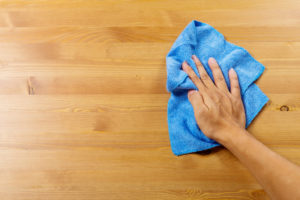- Keep your home clean to reduce allergens and dust particles.
- Control humidity levels between 30%-50% to prevent mold growth and maintain a comfortable living environment.
- Improve ventilation by opening windows and using exhaust fans in bathrooms and kitchens.
- Choose low-VOC or VOC-free products to minimize harmful chemicals in your home.
- Regularly maintain your air conditioning system to keep the air free of dust, dirt, and other contaminants.
As a homeowner, ensuring good indoor air quality is crucial for your health and well-being. Poor air quality can lead to various respiratory issues, allergies, and other health problems. Fortunately, you can take several steps to improve your home’s air quality. This guide will discuss five essential tips to help you enhance indoor air quality and create a healthier living environment for you and your family.
1. Keep Your Home Clean
Maintaining a clean and dust-free home is essential for improving indoor air quality. By maintaining a clean home, you can significantly improve the indoor air quality and reduce allergens.
Here are tips to keep your home clean:
Vacuum Regularly
Regular vacuuming is one of the best ways to keep your home clean and dust-free. Use a vacuum cleaner with a HEPA filter, which can effectively trap small particles and prevent them from recirculating in the air. Vacuum carpets, rugs, upholstered furniture, and other areas that accumulate dust. Don’t forget to vacuum under furniture as well!
Dust and Mop Your Floors
Dust mites, pet dander, and other allergens can build up on hard surfaces such as floors and countertops over time. Use a damp cloth or feather duster to wipe down these surfaces regularly. Make sure to mop your floors at least once a week to eliminate any allergens and dust particles.
Clean Bed Linens and Curtains
Dust mites, one of the most common causes of allergies, love warm, moist environments such as mattresses, bedding, curtains, and other textiles. To reduce their numbers in your home, wash all bed linens in hot water (at least 130°F) every two weeks. Additionally, vacuum or launder curtains regularly to remove dust mites.
Groom and Bathe Your Pets
Your furry friends can be carriers of dander and allergens that can settle in your home’s air ducts, carpets, and other surfaces. Make sure to groom your pets regularly and bathe them at least once a month to reduce the amount of pet dander in your home. Additionally, consider using hypoallergenic shampoos that are formulated for sensitive skin. Keeping your pets well-groomed will help keep your home clean and improve indoor air quality.
2. Control Humidity Levels

Proper humidity control is crucial for maintaining good indoor air quality. Excessive humidity can promote the growth of mold and mildew, while low humidity can cause dryness and irritation. Use a dehumidifier in damp areas such as the basement to reduce moisture levels and prevent mold growth. Consider using a humidifier to add moisture to the air in dry climates, especially during winter.
Monitor and maintain optimal humidity levels between 30% and 50% to prevent mold growth and maintain a comfortable living environment. Use exhaust fans in bathrooms and kitchens to reduce moisture buildup from cooking and showering. Regularly check for and repair any leaks or water damage to prevent mold growth and maintain healthy indoor air quality.
3. Improve Ventilation
Proper ventilation plays a vital role in maintaining good indoor air quality. Stale and stagnant air can lead to the buildup of pollutants and allergens. Ensure your home has adequate ventilation by opening windows and doors to circulate fresh air. Use exhaust fans in bathrooms and kitchens to remove moisture, odors, and pollutants.
Consider installing a whole-house ventilation system, such as an energy recovery ventilator (ERV) or heat recovery ventilator (HRV), which helps bring in fresh air while retaining energy efficiency. Regularly clean or replace air filters in your HVAC system to prevent the recirculation of dust and allergens. By improving ventilation in your home, you can effectively reduce indoor air pollutants and improve air quality.
4. Choose Low VOC Products
Volatile organic compounds (VOCs) are harmful chemicals in many household products, including paints, cleaning agents, furniture, and carpets. These chemicals can release toxins into the air, negatively impacting indoor air quality. When selecting products for your home, opt for low-VOC or VOC-free alternatives.
Choose paints labeled as low VOC or zero VOC, and consider using natural cleaning products. When purchasing new furniture or carpets, look for products certified as low VOC or have undergone off-gassing. Minimizing VOC-containing products can significantly reduce harmful chemicals in your home and improve indoor air quality.
5. Check Your Air Conditioning System

Regularly maintaining your air conditioning system is essential for improving indoor air quality. Clean and replace the filters in your HVAC system regularly to keep the air free of dust, dirt, and other contaminants.
Consider a professional air conditioner duct sealing service if there are any leaks or cracks in the ductwork, as this can lead to inefficient cooling and air leakage. A professional will ensure that your air conditioner is in good working order and provide the necessary repairs. They will also be able to identify any potential problems and recommend appropriate solutions.
In Closing
Improving indoor air quality is essential for creating a healthy and comfortable living environment. By keeping your home clean, controlling humidity levels, improving ventilation, choosing low VOC products, and regularly maintaining your air conditioning system, you can significantly enhance the air quality in your home. These steps will reduce the presence of allergens, pollutants, and toxins and contribute to your overall well-being. Prioritize indoor air quality to create a healthier and more enjoyable living space for you and your family.













